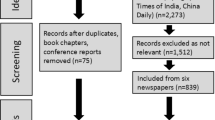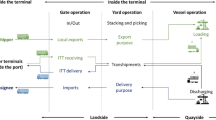Abstract
Freight transportation represents about 9.5% of GDP in the U.S., it is responsible for about 8% of greenhouse gas emissions, and supports the import and export of about 3.6 trillion in international trade. It is therefore important that the national freight transportation system is designed and operated efficiently. Hence, this paper develops a mathematical model to estimate international and domestic freight flows across ocean, rail, and truck modes, which can be used to study the impacts of changes in our infrastructure, as well as the imposition of new user fees and changes in operating policies. The model integrates a user equilibrium-based logit argument for path selection with a system optimal argument for rail network operations. This leads to the development of a unique solution procedure that is demonstrated in a large-scale analysis focused on all intercity freight and U.S export/import containerized freight. The model results are compared with the reported flow volumes. The model is applied to two case studies: (1) a disruption of the seaports of Los Angeles and Long Beach (LA and LB) similar to the impacts that would be felt in an earthquake; and (2) implementation of new user fees at the California ports.
















Similar content being viewed by others
References
Aagaard, B.T., J.L. Blair, J. Boatwright, S.H. Garcia, R.A. Harris, A.J. Michael, et al. 2016. Earthquake outlook for the San Francisco Bay region 2014–2043, 2327–6932. Reston: US Geological Survey.
Abadi, A., P.A. Ioannou, and M.M. Dessouky. 2016. Multimodal dynamic freight load balancing. IEEE Transactions on Intelligent Transportation Systems 17 (2): 356–366.
Agrawal, B., and A. Ziliaskopoulos. 2006. Shipper-carrier dynamic freight assignment model using a variational inequality approach. Transportation Research Record: Journal of the Transportation Research Board 1966: 60–70.
American Association of Port Authorities. 2010. North America container traffic 1990–2009. http://aapa.files.cms-plus.com/Statistics/CONTAINER%20TRAFFIC%20NORTH%20AMERICA%201990%20-%202009.xls. Accessed 28 July 2017.
Association of American Railroads. 2017a. Railroads and coal. https://www.aar.org/BackgroundPapers/Railroads%20and%20Grain.pdf. Accessed 30 July 2017.
Association of American Railroads. 2017b. Railroads and grain. https://www.aar.org/BackgroundPapers/Railroads%20and%20Grain.pdf. Accessed 30 July 2017.
Beuthe, M., B. Jourquin, J.-F. Geerts, and C.K. a Ndjang’Ha. 2001. Freight transportation demand elasticities: A geographic multimodal transportation network analysis. Transportation Research Part E: Logistics and Transportation Review 37 (4): 253–266.
Bureau of Transportation Statistics. 2013. Pocket guide to transportation 2013. https://www.rita.dot.gov/bts/publications/pocket_guide_to_transportation/2013/system_use_and_livable_communities/table_03_05. Accessed 29 July 2017.
Bureau of Transportation Statistics. 2015. Freight facts and figures. https://www.rita.dot.gov/bts/sites/rita.dot.gov.bts/files/TSAR_2015_final_0.pdf. Accessed 29 July 2017.
Cambridge Systematics, Inc. 2007. National rail freight infrastructure capacity and investment study. https://expresslanes.codot.gov/programs/transitandrail/resource-materials-new/AARStudy.pdf. Accessed 27 July 2017.
Clarke, D.B. 1995. An examination of railroad capacity and its implications for rail-highway intermodal transportation.
Crainic, T.G., and L. Gilbert. 1997. Planning models for freight transportation. European Journal of Operational Research 97 (3): 409–438.
Crainic, T.G., M. Florian, and J.-E. Léal. 1990. A model for the strategic planning of national freight transportation by rail. Transportation Science 24 (1): 1–24.
de Cea Ch, J.N., and A. Soto. 2003. A multi-modal supply–demand equilibrium model for predicting intercity freight flows. Transportation Research Part B: Methodological 37 (7): 615–640.
Dial, R.B. 2006. A path-based user-equilibrium traffic assignment algorithm that obviates path storage and enumeration. Transportation Research Part B: Methodological 40 (10): 917–936.
Fan, L., W.W. Wilson, and D. Tolliver. 2010. Optimal network flows for containerized imports to the United States. Transportation Research Part E: Logistics and Transportation Review 46 (5): 735–749.
Federal Highway Administration. 2016. Freight quick fact report. https://ops.fhwa.dot.gov/publications/fhwahop16083/fhwahop16083.pdf. Accessed 29 July 2017.
Friesz, T.L., J.A. Gottfried, and E.K. Morlok. 1986. A sequential shipper-carrier network model for predicting freight flows. Transportation Science 20 (2): 80–91.
Guelat, J., M. Florian, and T.G. Crainic. 1990. A multimode multiproduct network assignment model for strategic planning of freight flows. Transportation Science 24 (1): 25–39.
Ham, H., T.J. Kim, and D. Boyce. 2005. Implementation and estimation of a combined model of interregional, multimodal commodity shipments and transportation network flows. Transportation Research Part B: Methodological 39 (1): 65–79.
Harker, P.T. 1986. Alternative models of spatial competition. Operations Research 34 (3): 410–425.
Harker, P.T., and T.L. Friesz. 1985. The use of equilibrium network models in logistics management: With application to the US coal industry. Transportation Research Part B: Methodological 19 (5): 457–470.
Ishfaq, R. 2013. Intermodal shipments as recourse in logistics disruptions. Journal of the Operational Research Society 64 (2): 229–240.
Jones, D.A., J.L. Farkas, O. Bernstein, C.E. Davis, A. Turk, M.A. Turnquist, et al. 2011. US import/export container flow modeling and disruption analysis. Research in Transportation Economics 32 (1): 3–14.
Jourquin, B., and M. Beuthe. 1996. Transportation policy analysis with a geographic information system: The virtual network of freight transportation in Europe. Transportation Research Part C: Emerging Technologies 4 (6): 359–371.
Jourquin, B., and S. Limbourg. 2006. Equilibrium traffic assignment on large virtual networks: Implementation issues and limits for multi-modal freight transport. European Journal of Transport and Infrastructure Research 6 (3): 205–228.
Labys, W.C., and C.W. Yang. 1997. Spatial price equilibrium as a foundation to unified spatial commodity modeling. Papers in Regional Science 76 (2): 199–228.
Mahmassani, H., K. Zhang, J. Dong, C.-C. Lu, V. Arcot, and E. Miller-Hooks. 2007. Dynamic network simulation-assignment platform for multiproduct intermodal freight transportation analysis. Transportation Research Record: Journal of the Transportation Research Board 2032: 9–16.
Maia, L., and A. Couto. 2013. Strategic rail network optimization model for freight transportation. Transportation Research Record: Journal of the Transportation Research Board 2378: 1–12.
Miller-Hooks, E., L. Chen, R. Nair, and H. Mahmassani. 2009. Security and mobility of intermodal freight networks: Evaluation framework for simulation and assignment. Transportation Research Record: Journal of the Transportation Research Board 2137: 109–117.
Nagurney, A., J. Dong, and D. Zhang. 2002. A supply chain network equilibrium model. Transportation Research Part E: Logistics and Transportation Review 38 (5): 281–303.
Oak Ridge National Laboratory. 2005. Railroad network. http://cta.ornl.gov/transnet/RailRoads.html. Accessed 27 October 2017.
PIERS Global Intelligence Solutions. 2006. PIERS trade data. http://www.piers.com/. Accessed 28 July 2017.
Sheffi, Y. 1985. Urban transportation networks, vol. 6. Prentice-Hall: Englewood Cliffs, NJ.
Tavasszy, L., M. Minderhoud, J.-F. Perrin, and T. Notteboom. 2011. A strategic network choice model for global container flows: Specification, estimation and application. Journal of Transport Geography 19 (6): 1163–1172.
The Geography of Transport Systems. 2007. Modal split at selected North American container ports. https://people.hofstra.edu/geotrans/eng/ch2en/appl2en/NA_ports_modal_split.html. Accessed 29 July 2017.
Uddin, M.M., and N. Huynh. 2015. Freight traffic assignment methodology for large-scale road–rail intermodal networks. Transportation Research Record: Journal of the Transportation Research Board 2477: 50–57.
Wang, H., J. Gearhart, K. Jones, C. Frazier, L. Nozick, B. Levine, and D. Jones. 2016. Estimation of an origin–destination table for US imports of waterborne containerized freight. Transportation Research Record: Journal of the Transportation Research Board 2548: 35–42.
Wilson, A.G. 1970. Inter-regional commodity flows: Entropy maximizing approaches. Geographical Analysis 2 (3): 255–282.
Zhang, K., R. Nair, H. Mahmassani, E. Miller-Hooks, V. Arcot, A. Kuo, et al. 2008. Application and validation of dynamic freight simulation—Assignment model to large-scale intermodal rail network: Pan-european case. Transportation Research Record: Journal of the Transportation Research Board 2066: 9–20.
Acknowledgements
This paper describes objective technical results and analysis. Any subjective views or opinions that might be expressed in the paper do not necessarily represent the views of the U.S. Department of Energy or the United States Government. Sandia National Laboratories is a multimission laboratory managed and operated by National Technology & Engineering Solutions of Sandia, LLC, a wholly owned subsidiary of Honeywell International Inc., for the U.S. Department of Energy’s National Nuclear Security Administration under contract DE-NA0003525.
Author information
Authors and Affiliations
Corresponding author
Rights and permissions
About this article
Cite this article
Wang, H., Nozick, L., Xu, N. et al. Modeling ocean, rail, and truck transportation flows to support policy analysis. Marit Econ Logist 20, 327–357 (2018). https://doi.org/10.1057/s41278-018-0108-x
Published:
Issue Date:
DOI: https://doi.org/10.1057/s41278-018-0108-x




